How old are trees in the Vanderbilt Arboretum?
Many of the trees on Vanderbilt Campus are very large. But how old are they? We know from analyzing old photos and records that only the Bicentennial Oak is certain to be older than the university. It is estimated to be at least 240 years old. But what about other large trees on campus? How old are they? 50 years? 100 years? 130 years?

Holland McTyeire, c. 1875source: United Methodist Publishing House via WikiMedia Commons |
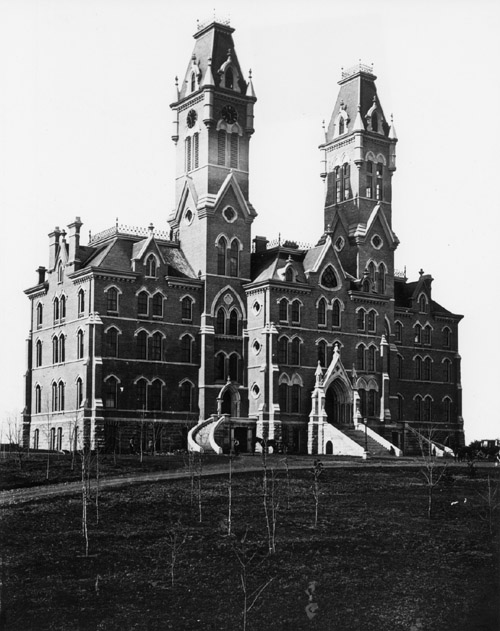
“Old Main” (now Kirkland Hall) in 1875, the year it was built. Notice the many small trees planted in the foreground.source: Vanderbilt University Special Collections and University Archives photo PA.BLD.KIRH.102 |
Bishop McTyeire’s legacy
We know from historical records that many trees were planted on campus in the first years of the university. How did that come about? The massive tree-planting campaign was one of the labors of Biship Holland McTyeire, who was the major force behind the creation of Vanderbilt. “Within a decade the raw campus of 1875 was already graced by adolescent trees, some fifteen to twenty feet tall, most, except for a few older oaks, dating back to a beginning 1,500 trees planted by McTyeire. In large part these came through a gift of 450 plants by Thomas Meehan of New York, drawn from his great nurseries at Germantown, Pennsylvania. The 1878 university Register could list 306 varieties of tres and shrubs on campus, or what it called the Vanderbilt Arboretum. McTyeire lovingly supervised the planting of every new variety he could identify and procure. Some exotics did not survive the Nashville climate. The close spacing often required later thinning, as did new construction. Few of the original plantings remain on the present [1985] campus, with a handful of venerable magnolias most distinctive. But in an age before most private families indulged in landscape planning, or even bothered with shrubs or trees, the campus was a haven of loveliness. In their publications, students frequently remarked the beauty of the campus, particularly in the spring and fall, and noted that it became a favorite destination for Nashvillians out, in carriage or buggy, for a Sunday afternoon drive.”1 In addition to the nursery-grown trees provided by Meehan, “many were saplings taken from the hills of Hillsboro Pike and raised in an arboretum on campus.” 2
How many of the large trees on campus are “McTyeire legacy trees” and are therefore 130 years or more old? How big must a tree be to be that old? These are questions that could be answered definitively by dendrochronology (acquiring tree-ring samples) and that kind of analysis may be done on some of the arboretum trees in the future. But for now, we can examine historical photos of campus to make some guesses about this.
Example: bur oak on Library Lawn
A large bur oak (ID: 2-108) grows on library lawn just north of the retaining wall of Stevenson Center. Its trunk has a diameter of 95 cm, which makes it one of the larger trees on campus. Its size makes it a candidate to be a McTyeire legacy tree. To test this hypothesis, we can track this tree’s history back into time using aerial photos of the campus. It is possible to georectify these photos using visible features that are stable over time, such as sidewalks. One can then use GIS to overlay the tree layer from the campus database to see the condition of the tree in the past. In this case, it is easy because the main sidewalks on library lawn have been stable for at least 100 years.

Library lawn, present. Bur oak 2-108 marked by arrow.
Image courtesy of Vanderbilt GIS service

Library lawn, 1959. Bur oak 2-108 marked by arrow.
Image courtesy of Vanderbilt Facilities Information Serices
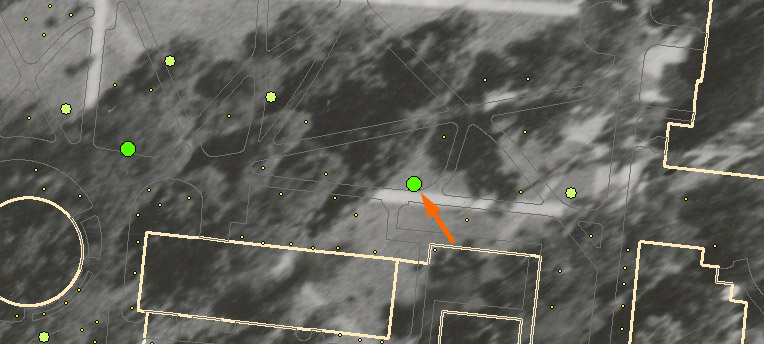
Library lawn, 1948. Location of bur oak 2-108 marked by arrow.
Image courtesy of Vanderbilt University Special Collections and University Archives
Although bur oak 2-108 is a dominant feature of today’s Library Lawn, it was a small and inconsequential tree in 1959 and was not present at all in 1948. That means that an oak tree with a diameter of just under a meter can be as young as 60 years.
Although it seems like a simple task to look for today’s trees on old photos of the campus to determine the trees’ ages, it is actually difficult because as one goes further back in time there are fewer stable landmarks such as buildings. The target tree becomes smaller and there is an increase in the number of large trees that don’t exist in the present. But it can be done in a few cases where the tree is distinctive location.
Another example: red oak in front of USN
Although the University School of Nashville (USN) is not presently a part of Vanderbilt, it was formerly the Peabody Demonstration School and closely associated with the history of Peabody College. Until recently there was a large red oak tree with a diameter of 115.5 cm standing prominently in front of the school. (Unfortunately, this tree was cut down in about 2017.)

Peabody Demonstration School, 1925 (top) and University School of Nashville, 2014 (bottom). Note that there is no sign of the large red oak in the top image.
Top image from USN historical photos exhibit. Bottom image by Steve Baskauf
Careful examination of the 1925 image shows that there is no sign of the red oak tree, even as a tiny sapling. From this we can conclude that it is possible for an oak to attain a diameter of well over a meter in less than 90 years.
The Library Sentinels
So what can we conclude from this analysis so far? In order for an oak tree in the arboretum to be a McTyeire legacy tree, it probably would need to be over a meter in diameter. However, it would not necessarily have to be as large as 1.5 meters because the Bicentennial Oak has a diameter of 149 cm. To find candidate oaks, we should probably be looking for trees over a meter in diameter that are located in places where we can track them back in time on aerial photos by locating their position relative to stable geographic features.
We have a series of aerial photos taken from the southeast of campus from about 1930 through 1962. There are five large trees visible on these photos that can be tracked back through time:
2-247, the big southern magnolia on the left as you face the central library on Library Lawn;
2-437, a big shingle oak that is up against the south side of the central library;
2-609, another shingle oak that stood by the southeast corner of the library (more on its fate later);
2-795, the big willow oak by the library loading dock near the 21st Avenue S. crosswalk;
2-123, the massive southern red oak that stands in front of Godchaux Hall.
A sixth tree, the willow oak 2-1030 between the library and Benson Chapel, is more difficult to locate because of its position relative to the library and other trees. These trees are among the 30 largest trees on campus and the four surviving oaks are among the 12 largest oak trees in the arboretum.

Noteworthy trees in the vicinity of the central library, 1962
Image from Vanderbilt University Special Collections and University Archives
In this image it is easy to locate the trees of interest because all of the buildings present in the area today are visible in the image, although the graduate wing was added between the library and 21st Ave. S. in 1969. This resulted in the destruction of the large trees between 2-609 and 2-795 in this photo.
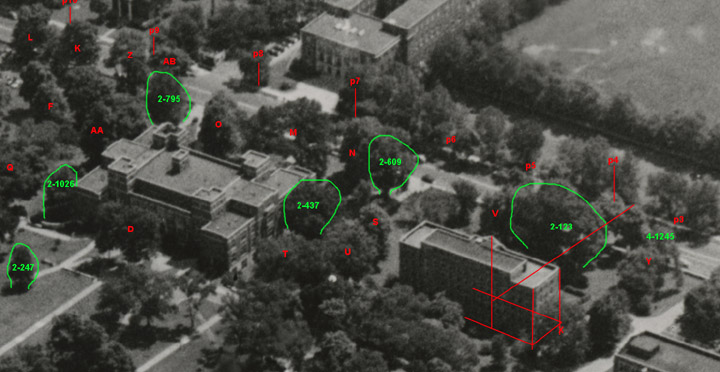
Noteworthy trees in the vicinity of the central library, 1948
Image from Vanderbilt University Special Collections and University Archives
This image from 14 years earlier is from a different vantage point, but it is still easy to recognize the six trees we are tracking because of their position relative to the library. There are many trees in this picture that do not exist at the present time, and they have been labeled with letters to make it easier to locate our six trees in earlier photos.

Noteworthy trees in the vicinity of the central library, mid-1930s
Image from Vanderbilt University Special Collections and University Archives
Moving the clock back by about ten years, there are fewer landmarks that can be used to determine the positions of the trees. Neither the library nor Benton Chapel are present. The ruins of the burned Wesley Hall have not yet been razed, which dates the photo to the mid-1930s. When the photo is georectified, the green dots mark where the base of the trees should be located. Comparison with trees labeled by letters allows the position of the five trees to be determined with some certaintly. The utility poles along 21st Ave. S. have been numbered for reference in earlier photos discussed below. A red arrow marks the location of the entrance of a path that goes from 21st Ave. S. up the hill to Wesley Hall.
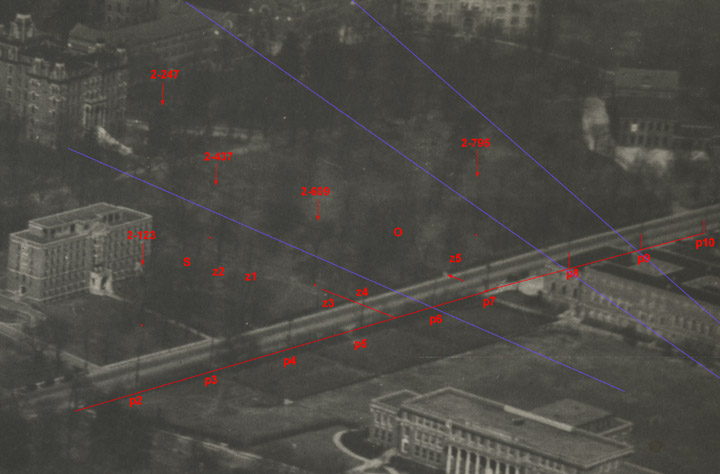
Noteworthy trees in the vicinity of the central library, c.1930
Image from Vanderbilt University Special Collections and University Archives
In this photo from about five years earlier, Wesley Hall still stands at the top left of the photo. The nursing building (now Godchaux Hall) on the left side of the photo is only about five years old, as is the Peabody Demonstration School at the bottom of the photo. The reference points marked on this photo are the same as in the previous photo. Again, georectification was used to locate the positions of the tree bases (small red dots). The quality of the photo is not good enough to locate 2-1030. This photo makes it clear why the magnolia 2-247 was planted in its location: it flanked the front steps of Wesley Hall on the right. The other large southern magonolia at the same end of Library Lawn (2-959) was probably its partner on the left side of the front steps, although it is obscured by other trees in most of these photos.
These trees, which are so noteworthy in the 21st century, were just several of many trees along 21st Ave.S. in 1930. Yet even at that date they were sizeable trees. We can get an idea of their size by enlarging the part of the photo that contains the shingle oak 2-609:
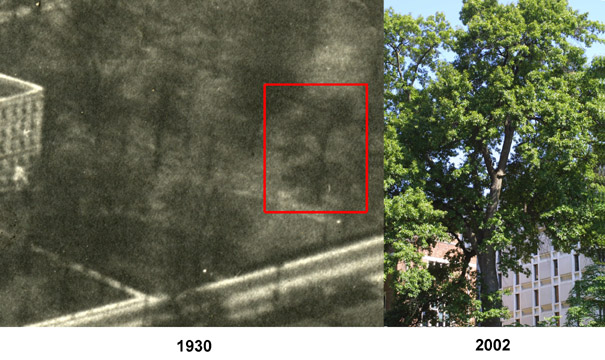
Left image from Vanderbilt University Special Collections and University Archives, right image by Steve Baskauf
Although due to extreme enlargement, the 1930 image is not sharp, one can clearly see the same branching pattern in the oak as was present seventy years later. So 2-609 was already a tall tree in 1930. By comparison with nearby buildings, it was probably about 15 meters (50 feet) tall at the time.

Construction of the nursing building, 1925
The southern red oak 2-123 is directly in front of the building.
Image by Williams and Nicks in 1925, and part of Vanderbilt University Special Collections and University Archives
This photo was taken to document the construction of the hospital and nursing building in 1925. It is difficult to distinguish most individual trees, but the giant southern red oak that stands in front of Godchaux Hall (the nursing building) today can be easily located. It is just one of many similar-sized trees in the vicinity. (Click here to view the full construction photo.)
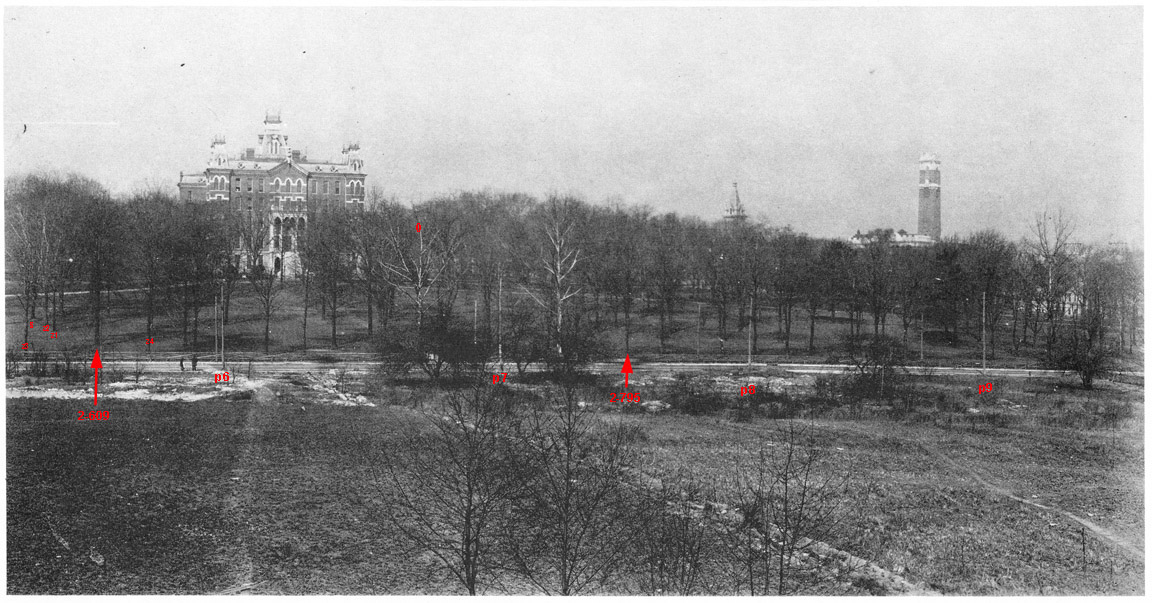
Vicinity of the central library, between 1907 and 1927
Looking across 21st Ave.S. towards Wesley Hall. Also visible (left to right) are the spire of Benson Science Hall, the single tower of Old Main (Kirkland Hall), and Furman Hall
source: Vanderbilt University Photographic Archive in McGaw, Robert A. 1978. The Vanderbilt Campus: A Pictoral History, Vanderbilt University Press, Nashville, p. 44.
This is the earliest known photo of the location where the central library now stands. Because Furman Hall is visible in the distance at the far right, we know that the photo is after 1907. The YMCA graduate school building (visible at the far right in the 1930 photo) was built in 1927 and is not seen in this photo. The purple sightlines and positions of the utility poles in the later photos (above this one) establish that this photo was taken somewhere near the current USN parking lot on 19th Avenue. (Click here to compare with the view in 2014.) Because of the relatively unkept condition of the foreground, the photo was probably taken before the PDS/USN building was built in 1925. On the far side of 21st. Ave.S. one can also see the wooden fence that surrounded the campus around 1900. So a date between 1910-20 would be a reasonable guess for this photo.
Because this is not an aerial photo, it is not possible to georectify it to locate the positions of the trees in which we are interested. However, the locations of the utility poles and the path leading from Wesley Hall to 21st Ave.S. provide reference points that can be compared with the 1930 and mid-1930s photos. The large tree labeled “O” (apparently a sycamore) is just to the left of the path. Although the positions of the shingle oak 2-609 and willow oak 2-795 can’t be known with complete certainty, their probably positions are marked with red arrows. The quality of this image does not provide great detail, but comparison of the shape of 2-795 in 2014 with the tree marked in the image show that they have the same general shape.

The willow oak 2-795 in 2014 and (probably) about a hundred years earlier
It is not possible to pick out 2-437 and 2-1030 from among the many other trees in the photo and the southern red oak 2-123 is too far to the left to be seen in this photo. However, what one can conclude from this series of photos is that the “library sentinel” oaks were large trees a hundred years ago and were just a few of many trees that formed a uniform-sized stand of trees between Wesley Hall (now Library Lawn) and 21st Ave. S. This situation is consistent with the hypothesis that these trees may have been some of the 1,500 trees planted by the efforts of Bishop McTyeire in the first years of the university.
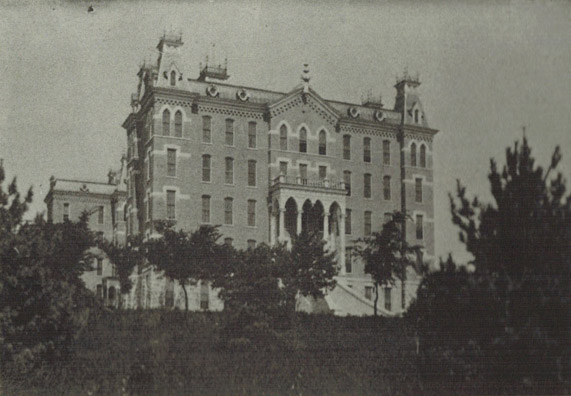
Wesley Hall, probably in the 1880s
source: Vanderbilt University Photographic Archive in McGaw, Robert A. 1978. The Vanderbilt Campus: A Pictoral History, Vanderbilt University Press, Nashville, p. 42.
Lending support to this idea is this last photo. Although the date is not known, it appears to be soon after Wesley Hall was built in 1880. The location is closer to the building than the previous photo, so the oaks we were tracking can’t be seen. But the trees are clearly small ones that were recently planted. Again, this is consistent with the hypothesis that the stand of trees between Wesley Hall and 21st Ave. S. were planted around the time of the start of the university.
Conclusions
If we accept the argument that the five oaks found near the central library were among the first 1,500 trees planted on campus in the late 1870s, what does that say about the size of 130 year-old oaks? The diameters of oaks 2-1030, 2-123, 2-795, and 2-437 are 135, 132, 117, and 114 cm respectively. Excluding the Bicentennial Oak, there are only four other oaks in that size range on the original Vanderbilt campus (128 cm Shumard oak 2-1021, 120 cm water oak 2-209, 117 cm white oak 2-161, and 115 cm black oak 2-584. So the “McTyeire legacy” oak club is probably a very exclusive one in the 21st century. More about magnolias on another page yet to come…
Epitaph for the sentinel 2-609
A few days before graduation in May of 2013, a storm caused a large part of the top of the shingle oak 2-609 to split off and fall onto the sidewalk between the library and Godchaux Hall. Within a day, the tree was down and its stump ground away to clean up the area before the arrival of the families of the graduates.
You can remember this tree that stood as a sentinal along 21st Avenue for over a hundred years when you see the cutout in the sidewalk that made room for its trunk and roots.
References
1 Conkin, Paul K. 1985. Gone with the Ivy: A Biography of Vanderbilt University, University of Tennessee Press, Knoxville, p.74.
2 Doll, Gay Nelle. 2001. In the Company of Trees. Vanderbilt Magazine Winter/Spring 2001, p. 16-19.
Analysis by Steve Baskauf – 2014